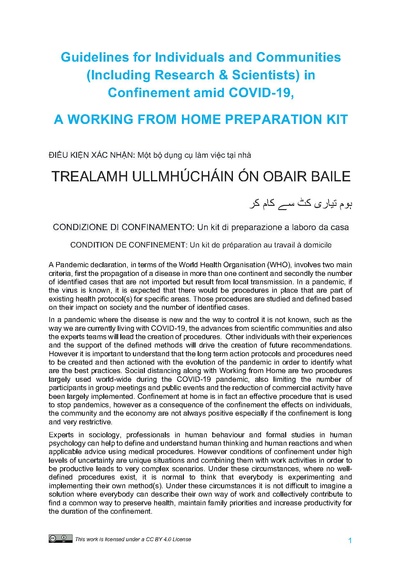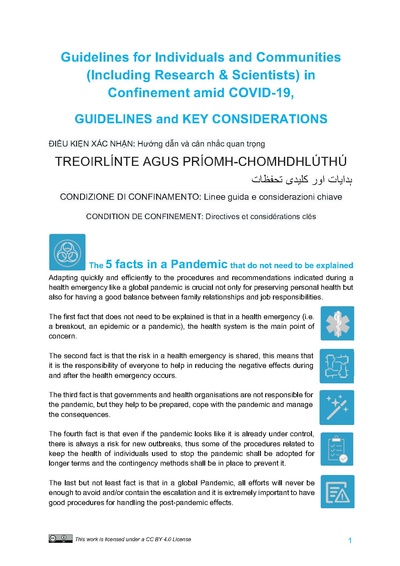Guidelines for Individuals and Communities in Confinement amid COVID-19
| Guidelines for Individuals and Communities in Confinement amid COVID-19 | |
|---|---|

| |
 WHO Pandemic Declaration | |
| Team Organizations | NUI Galway |
| Team Leaders | Martin Serrano |
| City, State | Worldwide |
| Contributors | Achille Zappa Yasar Khan Hoan Q. Nguyen Qaiser Mehmood Nial O’Brolchain Alex Acquier |
| Website | |
| Document | Download |
Description
A Pandemic declaration, in terms of the World Health Organisation (WHO), involves two main criteria, first the propagation of a disease in more than one continent and secondly the number of identified cases that are not imported but result from local transmission. In a pandemic, if the virus is known, it is expected that there would be procedures in place that are part of existing health protocol(s) for specific areas. Those procedures are studied and defined based on their impact on society and the number of identified cases. In a pandemic where the disease is new and the way to control it is not known, such as the way we are currently living with COVID-19, the advances from scientific communities and also the experts teams will lead the creation of procedures. Other individuals with their experiences and the support of the defined methods will drive the creation of future recommendations. However it is important to understand that the long term action protocols and procedures need to be created and then actioned with the evolution of the pandemic in order to identify what are the best practices. Social distancing along with Working from Home are two procedures largely used world-wide during the COVID-19 pandemic, also limiting the number of participants in group meetings and public events and the reduction of commercial activity have been largely implemented. Confinement at home is in fact an effective procedure that is used to stop pandemics, however as a consequence of the confinement the effects on individuals, the community and the economy are not always positive especially if the confinement is long and very restrictive.
Experts in sociology, professionals in human behaviour and formal studies in human psychology can help to define and understand human thinking and human reactions and when applicable advice using medical procedures. However conditions of confinement under high levels of uncertainty are unique situations and combining them with work activities in order to be productive leads to very complex scenarios. Under these circumstances, where no well-defined procedures exist, it is normal to think that everybody is experimenting and implementing their own method(s). Under these circumstances it is not difficult to imagine a solution where everybody can describe their own way of work and collectively contribute to find a common way to preserve health, maintain family priorities and increase productivity for the duration of the confinement.
We are addressing in this short document, using multiple views and based on experiences, the first and only question that in confinement circumstances in a pandemic people ask:
"How to manage living with family and at the same time working from home efficiently?”
In the following sections you can find information that can guide you or any other individuals that want to start or prepare themselves to scenarios of working from home, either for recommendation, necessity (i.e. a pandemic outbreak like COVID-19) or by personal initiative. The order they are described and all the activities listed, shall be followed in order to run a successful working from home process. All the collective information presented is the result of active participation of individuals that voluntary provided their experience and we build based on consensus these experiences to share. This information is made available with the objective of sharing experiences, being more effective and making sure that you are prepared for a working from home scenarios and that the working from home conditions don’t affect daily activities negatively. The information provided in the form of experiences and recommendations also aims to maintain our interpersonal conditions with family or the people with you are living and sharing common indoor spaces.

